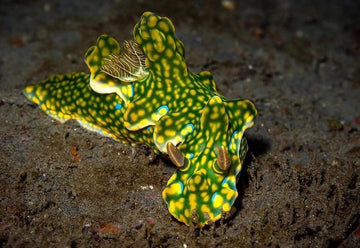Nudibranchs are extraordinary beings that amaze both scuba divers and biologists around the world. These molluscs fascinate for their intense and hypnotic color, magnificent shapes and adaptations, surprising habits and great differences between the different species.
Nudibranchs inhabit oceans around the world but are one of the great unknowns on the seabed for many. Each of the 3,000 species of nudibranchs that exist are as different as they can live in tropical waters up to Antarctica and even in hydrothermal vents, they inhabit seabeds from 10 to 2,000 meters deep and can be transparent but also bioluminescent. No, if you have seen one nudibranch you have not seen them all.
Despite the enormous differences between nudibranch species, we want to share with you these 8 nudibranch facts, unknown and very surprising.
1. THEY ARE SIMULTANEOUS HERMAPHRODITES
Nudibranchs are hermaphrodites, they have a male and female genital system at the same time. When two nudis meet, they put their genitals in contact to exchange their male gametes in order to fertilize their female gametes. Therefore, both nudibranchs will become pregnant from the encounter and give birth to their young, doubling the chances of continuing the species! Nudibranchs 1, mammals 0.

2. THEY ARE CARNIVORES
Among the favorite prey of nudibranchs are sponges, corals, anemones, hydroids, barnacles, fish eggs, sea slugs and yes, other beings of their own kind. In addition to being carnivorous and cannibalistic, they are quite picky eaters. There are different species of nudis that only feed on one type of prey. For example, the Flabellina iodinea feeds solely on a species of hydroid called Eudendrium ramosum, which possesses a pigment called astaxanthin that gives the nudibranch its brilliant purple, orange and red coloration.
 Flabellina iodinea. Image by mansonfotos
Flabellina iodinea. Image by mansonfotos
3. THEY ARE TOXIC AND POISONOUS
The vast majority of nudibranchs feed on poisonous beings such as jellyfish, corals or sponges, absorbing the toxins from their prey and secreting the poison through their skin. This allows them to defend themselves against their main enemies: fish. They also show that intense and luminous color that everyone in the animal world knows is a sign of danger.
There are cases of spectacular nudibranchs in many ways, such as the Glaucus Atlánticus or Blue Dragon. This intense blue nudibranch feeds on the poisonous Portuguese Man o'war, more specifically on their nematocytes, the glands that accumulate the poison. The Glaucus Atlanticus is able to store the poison, being even more powerful than that of its prey.
4. CAN PRODUCE ENERGY THROUGH THE SUN
Some species of nudibranchs have the ability to store photosynthetic algae within their bodies. They only need to eat for the first few weeks of their lives, and once they have enough, the algae present in their tissue provide enough light-harvesting energy to feed both beings.
Mugs for Ocean Lovers
SEE MORE MUGS FOR DIVERS5. GREAT COMMUNICATION SKILLS
With the naked eye we cannot see the trail of slime that nudibranchs leave as they are in the water, but, like the land snails, nudibranchs leave a trail behind them with a lot of information. This trail is full of chemicals that tells a lot: from nearby dangers that have been found to information on finding a mate, health status and even marking territory in some species.

6. UNKNOWN UNTIL THE 18TH CENTURY
The first record of a nudibranch occurred in 1776 by the Danish naturalist Otto Frederik Müller. More specifically, he recorded the Onchidoris muricata species off the coast of Japan.

7. SHORT LIFE EXPECTANCY
They can live for a year at most, so nudibranchs have to make the most of their short lifespan. In fact, most of these mollusks live only about 3-4 weeks, the luckier species rarely live more than a year.
8. THEY CAN SWIM
Most nudibranchs move on a broad, flat muscle called foot, which leaves a slimy trail. While most are found on the ocean floor, some can swim short distances in the water column by flexing their muscles.

























